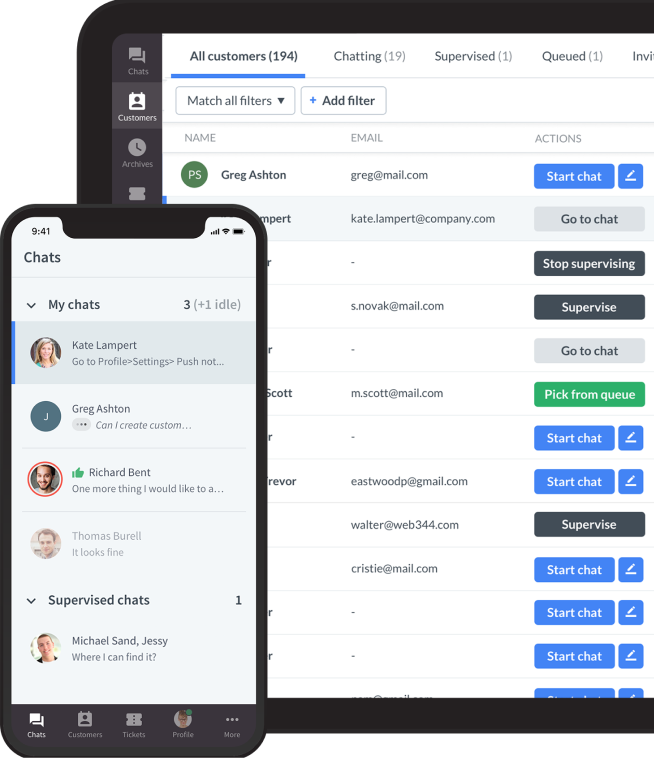Showing top 0 results 0 results found
Showing top 0 results 0 results found

Most of today’s communication happens online. It’s happening whether you’re asking your coworker when they’ll finish their task or if you’re chatting with a support agent to find out why your shipment is taking so long to arrive.
Have you ever thought about how much we rely on online communication?
From text messages to video conferencing, we live in a world where people communicate online more than ever. With the pandemic driving many of us to work and socialize from home, the importance of communication has only increased.
But with so many options available, navigating the digital landscape and figuring out what works best for you can take time and effort. In this article, we'll explore the pros and cons of online communication and offer some tips on communicating more effectively.
So whether you're a seasoned digital communicator or just getting started, read on to learn how to make the most of online communication.
The unique challenges of online communication
Imagine the following scenario:
You're at a conference and just finished a presentation. You notice that some audience members are nodding, some are taking notes, and others are looking at their phones. You can hear the hum of conversations taking place in the room. As you step down from the podium, several people approach you to ask questions and share their thoughts. You shake hands and engage in some small talk before going to the refreshment table.
Now, let's fast-forward to a different scenario. You're sitting in front of your computer, staring at your screen. You're on a video call with a group of colleagues, trying to discuss a project. One person's voice is garbled, another's video feed keeps freezing, and you can't see anyone's body language. You're distracted by notifications from your email and chat apps. After the call, you're left feeling frustrated and unproductive.
The second scenario is online communication, where we have been operating in quite a lot recently. As we increasingly rely on digital channels for communication, it's essential to recognize the unique challenges of digital communication and develop the necessary skills to navigate them.
Miscommunication
Have you ever received a text message or email you misunderstood, only to realize later that the sender meant something completely different?
It's happened to most of us and it's a typical example of miscommunication in online communication.
Unlike face-to-face communication, online communication lacks nonverbal cues such as facial expressions, body language, and tone of voice. This can lead to misunderstandings, as the intended tone of a message can be misinterpreted. For example, a sarcastic comment in a text message could be interpreted as a profound remark.
Another challenge is the brevity of online communication. In many cases, messages are limited to a certain number of characters or a short time. This can result in vague or incomplete messages, leaving room for interpretation.
Miscommunication can have serious consequences, including damage to relationships and productivity. To avoid it in online communication, it's essential to be clear and concise in messages, use appropriate tone and language, and clarify misunderstandings.

Lack of nonverbal cues
Have you ever talked with someone in person and noticed their body language change when a topic came up?
Maybe they crossed their arms, looked away, or leaned in closer to you. These examples of nonverbal cues can help us understand what someone is thinking or feeling. Offline communication relies heavily on nonverbal cues to convey meaning and establish relationships.
However, in online communication, these nonverbal cues are often absent. It's making it challenging to interpret messages and establish rapport. This can lead to misunderstandings and miscommunication.
To overcome this challenge, it's essential to be aware of online communication's limitations and compensate for the lack of nonverbal cues. One way to do this is to use emoticons or emojis to convey tone or emotion in messages. Another way is to use video conferencing or other tools that allow face-to-face communication, even virtual ones.
Distractions
We live in a world of constant distractions and online communication is no exception. When communicating with someone over the Internet, we often do so from a mobile device with messaging application, social media, email, and other notifications. This means we're constantly bombarded with distractions that make it difficult to focus on the conversation.
In verbal, synchronous communication, distractions are less of an issue because the conversation occurs in real-time and the participants are typically fully present and engaged.
How do you overcome distractions in online communication?
- Try to practice mindfulness. This means making a conscious effort to be fully present and engaged in the conversation and to minimize distractions as much as possible. You can do this by closing unnecessary tabs or apps on your device, putting your phone on silent, and finding a quiet space to communicate.
- Set boundaries around your communication habits. For example, set aside specific times of day for checking your email or social media and avoid using these platforms when you need to be fully present in an online conversation.
Knowing how distractions can affect your communication with others is essential. Suppose you constantly check your phone or scroll through social media during an online conversation. In that case, it can send a message to the other person that you need to be more fully engaged or interested in what they have to say.
Communication strategies for mastering effective conversations
Now that we've explored some of the challenges of online communication, it's time to dive into the strategies for effective communication. Thanks to the right approach, overcoming the challenges mentioned above and enhancing the quality of your online communication is possible.
Practical online communication is critical to building and maintaining strong relationships, whether you're communicating with a colleague, a friend, or a family member.
So let's explore some strategies to help you communicate more effectively online and improve your interpersonal relationships in the digital world.
Clear and concise language
Using clear and concise language is one of the essential strategies for effective online communication.
When communicating online, it's easy to fall into the trap of using overly complex language or technical jargon. This can lead to confusion and misunderstandings, mainly if you're communicating with someone who needs to become more familiar with your topic. To avoid this, try to use clear and straightforward language that's easy to understand.
Another essential aspect is brevity. Online communication moves quickly, and people are often bombarded with messages throughout the day. Getting to the point soon and avoiding lengthy explanations is essential to ensure your message is received and understood.
In addition, it's also important to be mindful of the context in which you're communicating. For example, when speaking with someone in a professional setting it is important to use formal language and avoid slang or colloquialisms. Similarly, if you're interacting with someone in your online network, use more informal language appropriate for the context.
Paying attention to tone and body language
One way to convey tone in online communication is through emojis or emoticons. While they may seem silly or trivial, these little icons can go a long way in bringing the intended tone of your message. For example, adding a smiley face to the end of a message can help give that you're being friendly and approachable (unless you're using a smile of hate :)).
Another way to convey tone is through the use of punctuation. Using exclamation points or question marks helps bring the intended style of your message.
There's little you can do about body language in online communication to convey physical gestures. However, you can use language to help give the intended body language. For example, if you want to share that you're nodding your head in agreement, you could say, "I completely agree," or "I'm nodding my head in agreement."
Active listening
Active listening is an essential aspect of effective communication, in-person or online.
Regarding video conferencing, active listening is crucial to ensure everyone feels heard and understood. One way to actively listen is to ensure you are fully present and engaged during the conversation. This means avoiding distractions like checking emails or browsing the internet during the call.
Another way to actively listen online is to use verbal cues to indicate that you're paying attention. This could include using phrases like "yes, I understand" or "go on" to encourage the speaker to continue.
Additionally, clarifying and summarizing what has been said is vital to ensure everyone is on the same page. This can be especially important in online communication, where picking up on subtle nuances can be difficult.
Choosing the right communication tool
Choosing the right communication channel ensures your message is delivered effectively and efficiently. With so many communication tools available, it's essential to consider which popular method is best for your needs.
For example, Facebook Messenger might be a good option for communicating quickly with colleagues or friends. It's easy to use and allows real-time messaging, making it ideal for quick exchanges.
On the other hand, if you need to have a more formal or detailed conversation, a video conference might be more appropriate. Video conferencing allows for face-to-face interaction, which is essential for building relationships and ensuring everyone is on the same page.
When choosing a communication tool, it's also essential to consider the needs and preferences of the other person or people involved. For example, video conferencing is not a viable option if someone has a poor internet connection.
Best channels to communicate online
With the rise of online communication and new media channels, people can now connect anywhere in the world at any time. From social media platforms like Facebook Messenger to email services like Yahoo Mail, the options for communicating online are virtually endless.
First up is email.
Email has been around for decades and is still one of the most widely used online communication channels. One of the most significant advantages of email is its convenience. You can send and receive messages at any time of day or night, and you don't have to worry about the other person being online simultaneously.
Email lets you attach files, photos, and other documents, making it an excellent option for work-related communication. Plus, most email services offer powerful search features, making finding old messages and important information accessible.
If you're busy, you can also use professional email templates suitable for different scenarios.
Chats and messengers
Another popular online communication channel is instant messaging.
Facebook Messenger, WhatsApp, and Slack are just a few examples of instant messaging services that millions use daily. Instant messaging lets you send and receive messages in real time, making it perfect for quick conversations.
One of the most significant advantages of instant messaging is its speed. You can get an answer to your question or response to your message almost instantly. Plus, most instant messaging services allow you to send photos, videos, and other files, making it easy to share information with others.
Video conferencing
Video conferencing is also a popular online communication channel, especially today, where remote work has become the norm for many people.
Services like Zoom, Skype, and Google Meet allow you to have face-to-face conversations with others, no matter where you are. One of the most significant advantages of video conferencing is its ability to create a more personal connection.
Seeing someone's face and hearing their voice can help you feel more connected to them, even if you're not in the same room. Video conferencing is also great for group meetings, allowing everyone to see and hear each other in real time.
Voice over Internet Protocol (VoIP) calls.
VoIP calls, also known as Voice over Internet Protocol calls, have become increasingly popular in recent years due to their many advantages. These calls allow you to make voice calls over the internet instead of using traditional phone lines. Some famous examples of VoIP calls include WhatsApp, Viber, and Skype.
Here are some advantages of using VoIP:
- With a stable internet connection, you can call anyone worldwide for free or at a fraction of the cost of traditional phone calls.
- Since VoIP calls rely on an internet connection instead of a traditional phone line, the quality of the call is often much better.
- VoIP calls are also incredibly convenient. You can make calls from anywhere worldwide as long as you have an internet connection.
Best practices for effective online communication
Just like face-to-face communication, effective online communication requires specific skills and techniques.
Let's discuss the best practices for effective online communication to help you better convey your message, avoid misunderstandings, and build stronger relationships.
Choose the appropriate medium for your message
With so many online communication channels, deciding which one to use can be overwhelming.
Different messaging channels have their unique features and advantages. For instance, email or instant messaging might be appropriate if you need to discuss a complex project with a colleague. However, if you need to give feedback on a presentation, a video or voice call using a platform like Skype or Zoom may be more effective.
When choosing the appropriate medium, you should consider factors such as the urgency and importance of the message, the recipient's preferences, and the complexity of the message. The goal is to select a medium that allows you to convey your message clearly and effectively while considering the context of the message.
Learn more about the people you talk to
One of the essential aspects of effective online communication is understanding the people you're talking to. As technology evolves and communication channels become more diverse, it's necessary to recognize that different generations have different communication preferences.
For example, according to the Gen Z Report by LiveChat, Gen Z (born between 1997-2012) prefers instant messaging and chat apps like Snapchat, Instagram, and TikTok to socialize and communicate with friends while opting for email and texting for more professional or formal interactions. They also tend to value authenticity and transparency in their communication.
On the other hand, millennials (born between 1981-1996) often prefer email and texting as a means of communication and tend to appreciate humor and casual language in their interactions. They often use Facebook and Twitter to socialize and network.
And Baby Boomers (born between 1946 and 1964) tend to prefer phone calls and face-to-face conversations and value politeness and formal language. They also value clear and professional communication, focusing on proper grammar and spelling.
It's also worth noting that these preferences can vary widely within each generation and can be influenced by personal experience, cultural background, and individual personality. The key is to approach online communication with a willingness to learn and adapt to the preferences of the people you're communicating with.
Get a glimpse into the future of business communication with digital natives.
Get the FREE report
Respect others' time and boundaries
Respect is the foundation of any healthy relationship. When communicating online, respecting others' time and boundaries is essential.
First and foremost, be aware of the time you're taking up when communicating online. Unlike in-person conversations, it can be difficult to tell when someone needs to move on to other tasks or feels overwhelmed. To respect others' time, keep your messages and conversations concise.
Another important aspect is being mindful of the type of communication you're engaging in. People have different comfort levels when it comes to various kinds of online communication, and it's important to respect those boundaries.
For example, some people prefer to communicate via email, while others prefer instant messaging or video calls. Take the time to understand their preferences and work within those boundaries.
Consider cultural differences and language barriers
Finally, it's essential to consider cultural differences and language barriers between you and the person you're communicating with. With the rise of globalization and the internet connecting people worldwide, it's essential to know how different cultures and languages can impact communication.
One of the most important things to remember is that not everyone may speak the same language fluently, and it's essential to be patient and understanding when communicating with someone who is not a native speaker. Take the time to listen carefully, speak clearly, and ask clarifying questions to ensure you understand their intended meaning.
It's also important to be aware of cultural differences that may affect how people communicate. For example, some cultures may emphasize directness more, while others may prioritize politeness and avoiding conflict. Awareness of these differences can help you tailor your communication style to be more effective and respectful.
Another consideration is using idioms and other expressions that may need more universally understood. While they can add color and personality to your communication, it's essential to use them sparingly and be willing to explain their meaning to avoid confusion.
By being mindful of cultural differences and language barriers, you can ensure that your online communication is respectful, effective, and inclusive.
Wrapping up
Okay, that's it. We have explored the world of online communication channels, examining different methods, their advantages and disadvantages, best practices, and tips for effective communication. Ultimately, online communication is an excellent way to connect with people, and we should use it to its fullest potential.
So, let's keep the conversation going and make the most of our online communication channels!
Get a glimpse into the future of business communication with digital natives.
Get the FREE report








Comments